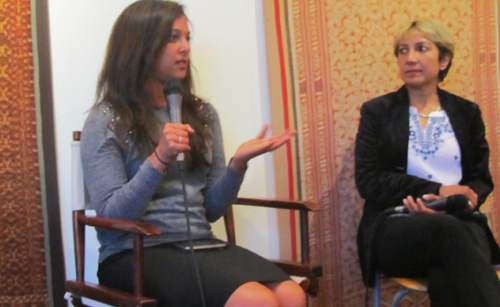
LOS ANGELES – “Ask a Muslim” is a monthly series, that is free and open to the public, that addresses the public’s questions surrounding Islam today. It takes place in this city on the first Thursday every month at The Markaz, Arts Center for the Greater Middle East.
Audiences are invited to come learn everything the religious teachers and the mosque don’t want to talk about. The imam you meet here is not your grandmother’s imam!
A curious group of about 20 showed up last Thursday, May 5, to hear two presenters review some prominent issues regarding women’s rights in Islam. The two women were Ani Zonneveld, born in Malaysia and a founder of Muslims for Progressive Values (MPV) who has become an imam, and Momal Iqbal, American-born immigration lawyer of Pakistani descent. Their views are untraditional, but are based on what the Koran actually says, not on the layers of interpretation that have been added later (by men, of course).
Interfaith marriage
First off: Is interfaith marriage permissible for Muslim women? On this question, Iqbal has an especially personal point of view. She got married in January to a man she describes as “Jewish-Catholic.” Ani Zonneveld performed the ceremony, which incorporated elements from all three of the Abrahamic religious traditions, so that everyone attending the wedding could feel that their backgrounds were being acknowledged. “It’s so incredibly difficult to find a woman imam anywhere,” Iqbal says. Zonneveld added that it is about creating “a new American Muslim tradition.”
The Koran is specific about whom a Muslim man can marry, but whom a Muslim woman can marry is ambiguous. It is not true, according to the panelists, that the father’s religion must determine the religion of the children. In some places, subsequent interpretation of the Koran holds that the woman is the property of the husband, but in fact the Koran specifies that marriage is a contract between two consenting partners, and what terms the couple come to are not determined.
There is no prohibition against a wife working outside the home, earning, spending and keeping her own money. Many Muslim women are not told, and do not know this. What’s taught in many places is regressive, including child marriage – which, by the way, is also far from unknown in non-Islamic societies. In those cultures, illiteracy, ignorance, and patriarchy are prevalent. The panelists reminded the audience that traditional local cultures predate Islam in much of the Muslim world, and many of those tribal rules were imported into Islam, but legal justification for them cannot necessarily be found in the Koran.
In Iqbal’s case, her family was supportive of her marriage to a non-Muslim man. “Maybe because I was so old!” she quipped.
Can women lead prayer?
The standard image of Muslims at prayer features a male imam, but can a Muslim woman lead a co-ed congregation? Zonneveld pointed out that the Prophet Muhammad himself appointed a woman to be a prayer leader. MPV does not separate women and men in prayer, but rather embraces “Mecca-style,” women and men together. When reminded by segregationists that kneeling in prayer, men would be looking directly at the butts of women, Zonneveld replied, “It goes both ways! Get your minds out of the gutter!”
The Koran says you will be judged by your spirituality and your deeds, not your religion. The values of social justice and egalitarianism are open to men and women alike.
Is “honor” killing in the Koran?
Newspapers that morning reported a 15-year-old girl burned alive in Pakistan for assisting a friend to elope and escape an arranged marriage. “Honor” killing is not mentioned in the Koran, but the panelists said the Koran is used as a shield for this and many other practices. It is traditionally used only against women, although the question came up from the audience: Aren’t there “honor” killings of gay men in some places? Yes, Zonneveld answered; that is because according to the local interpretation of Islamic law, such persons are not considered men as they have abandoned male roles and privileges, thus sacrificing their right to be treated as men – and earning the punishment accorded to women.
Wearing the hijab
Many cultures insist on some form of head or hair covering for women, and some for men as well. There is little basis for the hijab, the head covering, in the Koran, however. Historically, the custom has cultural, anthropological, and theological influences, and these vary widely from place to place. The panelists explained that historically, where slavery or extreme forms of servitude existed, women could be required to parade before their masters bare-breasted, with no hijab in sight. So the amount of covering often related to class and status. They offered the example of Persia, where, they said, only elite women wore the hijab, as if to say, “We will not be made sexual objects.”
The panelists also spoke to the presence of racial prejudice in some cultures: The more bodily covering a woman wears, the less tan she will become, thus preserving her “whiteness.”
The full head-to-toe covering, sometimes including the veil, previously unseen in some countries, has appeared only in the last dozen or so years. This is the influence of Wahhabism, a local form of the faith that arose in Arabia in the 19th century, and which is now promoted by the Saudis. Saudi Arabia exports its religion widely, building mosques and providing schools and teachers both in traditionally Islamic countries and in the West, where significant numbers of Muslim immigrants live. Zonneveld calls it “not a very Islamic Islam” and a “cancer.” In her native Malaysia, puppet theatre was once very popular, but in those areas where Wahhabism has taken over, it has been banned, along with other arts, as “haram” (unclean, inappropriate, forbidden). Expressions of this viewpoint can be seen in the physical destruction of pre-Islamic statuary in the Middle East and Central Asia.
Today, the hijab can be viewed as a kind of uniform that makes a woman conscious of representing her people, much as a yarmulke (or kippah) serves to identify an observant Jewish man. Married Orthodox Jewish women also always wear head and hair covering, indicating that this practice is far from uniquely Muslim. In this, as in many other ways, what we identify as Muslim customs are indeed much more widespread than we might first believe. Neither Zonneveld nor Iqbal wore a head covering.
What about FGM?
Female genital mutilation (FGM) is a highly volatile subject, but progress is being made to oppose and ban it. It is not religious, says Zonneveld: It’s “150 percent culturally based,” a political tool used in the name of religion. Many pre-Islamic norms included the ideas of women as property, child marriage, and clitoral cutting, all meant to control the population. All the Koran says is that “the man is the guardian of the woman,” but, the panelists said, nothing about that suggests the oppressive tyranny that occurs in many Islamic societies. That comes from Sharia law, which varies widely from place to place.
FGM takes on varied forms in different places – and also exists in non-Islamic cultures. In her native Malaysia, said Zonneveld, FGM amounts to taking just a drop of blood from a newborn girl’s clitoris. Elsewhere FGM can mean partial or total cutting away of the external female genitalia, and it can lead to serious health complications and even death for the girl.
The panelists said that FGM stems from men’s fear that they cannot leave their wives at home unless they have had the operation. Pressure from women (and perhaps from international bodies where this might have an effect) has led to FGM banning, at least in principle, in Nigeria, Ghana, and Somalia. Muslim women have to organize and go to the imams to challenge the practice of FGM, but change will come slowly. The fact is that FGM is not to be found in the Koran. “There are imams who promote women’s rights,” Zonneveld affirmed, “and we know they’re putting their necks on the line.”
It bears mentioning that Islam also practices male genital mutilation in the form of circumcision, which is also the custom among Jews and others, and often for cultural rather than religious reasons. This was practiced in Pharaonic Egypt, and the Jews may have adopted it from there.
Speak up and speak out
In the Q&A that followed, someone asked about “reform” movements in other religions, such as Judaism and Christianity, and whether or not Islam was capable of moving in that direction. Iqbal, who in her search to participate in a modern, culturally appropriate marriage recently found Zonneveld, replied, “MPV is bringing back the essence of what Islam really is.” Zonneveld spoke of all the different sects and schools of Islam around the world, every one of them created by men. What she is saying to them is, “Hey, you guys are just making it all up. We are going back to the pure spiritual Islam – love, compassion, inclusivity.”
As girls and young women become more educated, the panelists said, they are changing the discourse on the ground. Although horrific attacks on girls’ schools do occur as a means of preserving backward hierarchies, the more general picture now is one of hope.
The Muslim world is transforming rapidly, but anti-Islam forces, especially in the West, are, in Zonneveld’s words, “powerful and frightening.” She asks us to “speak up and speak out.” MPV now has chapters in over 20 countries and is recognized as an NGO at the United Nations.
The Markaz is located at 5998 W. Pico Blvd., Los Angeles. “Ask a Muslim” is presented by Muslims for Progressive Values and The Markaz. The Wikipedia entry on MPV can be found here.
Photo: Momal Iqbal left, and Ani Zonneveld right / Eric A. Gordon









